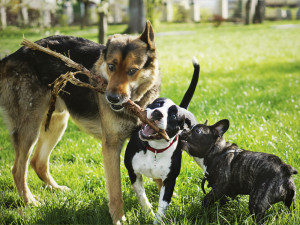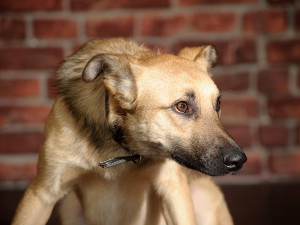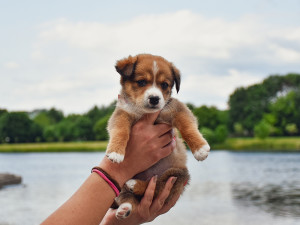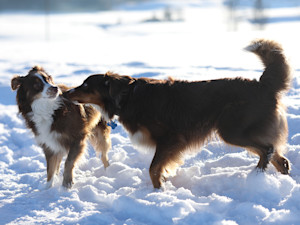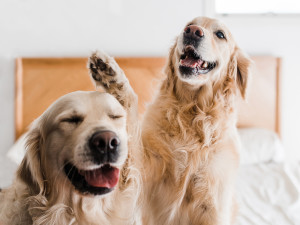13 Common Dog Behavior Myths Overheard at Dog Parks
Many pet parents share information at the dog park, but is the information always accurate?
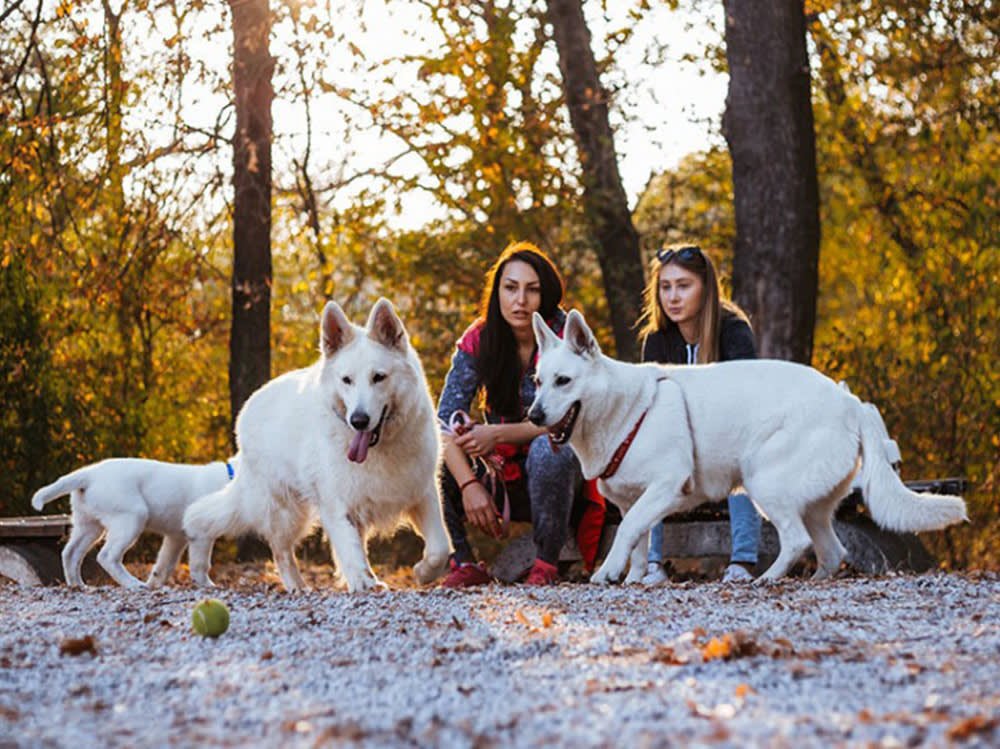
share article

Your pet wants you to read our newsletter. (Then give them a treat.)
Here’s a confession: Eavesdropping is a source of great joy for me. Usually, I just take in what I hear, but it’s a different story at the dog park. Some of the comments I’ve overheard about dog behavior makes me cringe. Here are some common dog behavior myths I’ve heard at dog parks, as well as some truths.
“The dog park is not for every dog.”
True, the dog park isn’t for every dog. Dog parks can be absolutely wonderful experiences for many dogs, allowing them to play, run off-leash, and sniff in open spaces. However, there are also plenty of dogs who experience the dog park not as a playground but as a gladiator pit. Lots of dogs are overwhelmedopens in a new tab in the presence of groups of dogs, or they’re terrified of people they don’t know. Still, others are aggressive and may bite other dogs or people. You shouldn’t assume that a dog-park visit will be a positive thing for all dogs.
“So many problems can be avoided by moving rather than standing still.”
I agree, and so does every dog behaviorist and dog trainer I know. Many dogs feel relaxed when they’re on the move but tense up when other dogs and people gather in groups. When everyone stands around, tension can build, which can lead to angst, scuffles, and even fights. Just walking takes the pressure off. Many dogs who might have gotten into trouble will do fine if people keep walking, especially away from the ramped-up energy around the park’s entrance gate. Do everyone a favor by strolling rather than standing.
“It’s only appropriate play if all the dogs are having fun.”
It’s true. Play is really hard to define as a scientific concept. It’s also hard to differentiate appropriate play from inappropriate play, by which I mean play that may lead to aggression or to one or more participants being overwhelmed. Why is this so?
Play contains elements of other behaviors, such as predation, fighting, and courtship. In play, these elements are modified and repurposed, but that can make it a real challenge to accurately interpret them in a consistent way. Is it fighting or play fightingopens in a new tab? Is it pretend predatory behavior, or is it about to get real? One of the best ways to assess play is to observe each dog. Do they seem happy? Do they seem to be having a good time? If you separate them, do they want to go back?
The bottom line: Though play is hard to define and sometimes a challenge to assess, if a dog is not having a good time, the play should not be considered acceptable.
“It’s a good sign when dogs pause while playing.”
Yep, this is true. Whether it’s rough-and-tumble wrestling, pouncing, or chasing, healthy dog play has a rhythmic cadence: happy play alternated with pauses. The pauses need not be long — even half a second will do — but they should occur frequently.
Dogs do different things during these brief pauses. Sometimes they just stop whatever it is they’re doing and separate from each other. Some dogs will look around, others will lie down, and still, others will offer play bows. Pauses allow each dog to decide whether to continue playing or switch to sniffing the grass, chasing squirrels, or playing with another dog.
When dogs are playing appropriately with one another and including lots of brief pauses in their fun, they’re exhibiting emotional control. If they have the emotional control to execute frequent pauses, they most likely have the emotional control to prevent the play session from escalating into an out-of-control brawl or aggression, both of which have the potential to result in serious injury. When play between two dogs has no pauses, trouble is much more likely to happen.
“It’s great to see those dogs switching who’s chasing whom.”
Play is a reciprocal endeavor that requires cooperation; everyone involved should be a willing participant. Switching chaser/chasee roles checks both those boxes. Reciprocity is present when both dogs get to engage in both roles.
Cooperation is necessary for the change to happen; if either dog wants to stop, they are free to do so. You’ll sometimes see a dog who will chase but refuses to be chased — if the other dog tries, the one refusing either stops moving altogether or charges the dog who tries to run at them. If a dog is only being chased, it’s hard to know if they are trying to run away or enjoying the game, but a chaser can always stop if they choose to.
“Let’s not assume being alpha has anything to do with that behavior.”
Decades ago, almost every behavior problem was assumed to be about a dog wanting to dominate either people or other dogs. Thankfully, the field has come a long way since then, and we now know that it’s wise to stop blaming undesirable canine behavior on dominance hierarchies or a dog’s desire to be alpha. That was never very accurate or very helpful to our dogs. In fact, assuming that dogs were trying to dominate others resulted in antagonistic behavior toward dogs. That outlook made so many behavioral issues worse and damaged many relationships.
“Reinforcement drives behavior.”
Many dog trainers consider this to be the fundamental truth about our work. It is absolutely true that positive reinforcement opens in a new tabstrongly influences the way that dogs (and members of other species, too) act. Any reinforced behavior is strengthened and becomes more likely to occur in the future — essentially, the definition of positive reinforcement. While practical applications of this are plentiful, there are many complexities, such as the natural tendency of dogs to perform, or not perform, certain behaviors because the reinforcer is internal rather than external (that is, controlled by us). However, at its simplest, it’s pretty straightforward: Reinforce the behavior you like and don’t reinforce the behavior you don’t like. How you respond to your dog’s behavior today is fundamental to the behavior you’ll see in the future.
“That dog is growling; they must be aggressive.”
This is a myth. Though many aggressive dogs growl, and a growl should always be taken seriously and evaluated, plenty of non-aggressive dogs growlopens in a new tab, too, and it can be tricky to tell the difference.
Some dogs growl to let another dog or a person know they don’t like what’s happening. That doesn’t mean they intend to harm anyone. It just means they are communicating. In some cases, a growling dog may be trying to defuse aggression by telling an actually aggressive dog to knock it off. More commonly, at the dog park especially, growling is a part of the perfectly appropriate play — the canine equivalent of joking around in an “I’m-going-to-get-you” kind of way. Growling is very common in play and has nothing to do with aggression in that context.
“Dogs have to be close to the same size to be good play buddies.”
Being compatible matters when it comes to play buddies, and so does safety, which is why many people seem to think that only dogs who match in size should be playing together. However, dogs can be compatible and play safely even if they are very different in size. Compatibilityopens in a new tab is about enjoying being together and engaging in play that works for both.
Similar levels of arousal or speed can make dogs compatible, and that’s about more than size. It’s true that being wildly mismatched in terms of size may present a safety issue for the smaller dog, but that depends on the individual dog. Many big dogs play beautifully with their little buddies by rolling onto their backs, lying down, or being gentle in their movements. Although I recommend watchfulness if one dog is much bigger than the other, extreme size difference is not a dealbreaker for good play.
“All dogs of that breed play the same way, so they can only play with other dogs of their breed.”
This is false. Whether the preferred game is chase, wrestling, or boxing, the best buddies often have the same play style, and different play styles can be problematic. If one dog only wants to wrestle and the other only wants to play chase, the results can be much like two children when one is trying to play checkers while the other is trying to play tag.
Though there are play-styleopens in a new tab-related breed tendencies, none of them are unique to a single breed, and most dogs play in more than one way. There is no such thing as a breed with a single play style that all members of the breed adhere to. No matter what play style a dog engages in, many other dogs play the same way, and those dogs are sure to be members of a variety of different breeds and mixed breeds, too. Play sessions need not be segregated by breed.
“They’ll work it out.”
Of all the erroneous statements I hear at dog parks, this one causes me the most distress. That’s because it can easily lead to physical or emotional injuries to dogs. When dogs are intense, awkward, aggressive, or potentially aggressiveopens in a new tab in social interactions with each other, it’s wise for people to defuse the situation. That can be done by calling the dogs, moving away from them to get them to disengage from each other and follow you, or talking in a calm and happy way to change the mood. In some other cases, the dogs may need to be physically separated and kept apart. There is no reason to leave dogs to fend for themselves in stressful situations.
If the issue is no big deal, calming everyone down and getting them to move away from each other does no harm. If the situation is more serious, it is essential to take steps to prevent an escalation into serious trouble. The idea that dogs should “work it out” implies that they will negotiate and compromise to some kind of agreement or that one dog will defer to the other, and the one offered deference will back off. We cannot count on dogs to do either of these things, but they need to be able to count on us to step in and help them out so that no one’s hurt or scared.
“My dog has a high prey drive and that’s why they keep chasing your dog. Don’t worry about it.”
If a dog’s relentless chasing has to do with prey driveopens in a new tab, it definitely is something to worry about. Dogs who chase other dogs as they would chase prey might hurt them. When dogs are playfully chasing one another, they regard each other as social partners, not as prey.
And just because someone says the reason for their dog’s wild chasing is high prey drive doesn’t mean it’s true. Their dog might be a bully or simply have poor social skills. “Prey drive” is such a controversial term that it’s hard to say whether that’s what’s going on. Still, I regard any dog relentlessly chasing another dog with single-minded intensity as cause for concern. As I mentioned earlier, switching roles in chase games is preferable.
No matter the reason that one dog persistently chases another, it can be a cause for concern if the one being chased seems to be attempting to get away. If the dog being chased is having a great time and even encourages the other dog to chase her, that’s an indication that the chasing is playful and probably okay. However, suppose the dog doing the chasing is doing so because of high prey drive. In that case, that’s not a reason to relax and quit worrying but rather a reason to interrupt that activity and find other activities for both dogs.
“It’s important to bring puppies to the dog park for socialization, especially when they’re very young.”
Nope, this isn’t true. Done right, socialization exposes your dog to lots of objects, experiences, people, dogs, cats, other social partners, and sights and sounds. It’s easy to teach dogs to accept new things throughout their lives if they have many and various positive experiences early on.
For puppies, a little exposure goes a long way. Puppies are very impressionable, which is great. However, the downside is that negative experiences at a young age can have serious consequences. Bad experiences can be damaging to puppies, and it is far too easy for them to have a bad experience at a dog park, where they can be aggressively barked at, bitten, rolled, slammed into, or held down. Many puppies are even overwhelmed by large groups of dogs running over to them at once. Taking a puppy to a dog park risks teaching that puppy that other dogs are scary, which is the opposite of proper socialization.
That doesn’t mean avoiding all dogs, however. It’s critical for proper puppy social development that they interact with other dogs of various ages, sizes, and breeds, but it’s wise to choose those dogs carefully, so your dog has positive experiences. The dog park doesn’t allow you to choose which dogs interact with your puppy and is not the right place for socialization.

Karen B. London, PhD, CAAB, CPDT-KA
Karen B. London, Ph.D., is a Certified Applied Animal Behaviorist and Certified Professional Dog Trainer who specializes in working with dogs with serious behavioral issues, including aggression, and has also trained other animals including cats, birds, snakes, and insects. She writes the animal column for the Arizona Daily Sun and is an Adjunct Professor in the Department of Biological Sciences at Northern Arizona University. She is the author of six books about training and behavior, including her most recent, Treat Everyone Like a Dog: How a Dog Trainer’s World View Can Improve Your Lifeopens in a new tab.
Related articles
![Two hands holding a very young tan and white puppy up in front of a lake landscape]()
How to Socialize a Puppy
Everything you need to know to get your new addition off to a good start.
![Two Australian Shepherd dogs meeting in the snow]() opens in a new tab
opens in a new tabAre Your Dogs Arguing With Each Other?
How to tell the difference between dog aggression and communication.
![Two dogs acting rowdy at the lake while a person tries to calm them down]() opens in a new tab
opens in a new tabMy Dog Is Misbehaving. What Should I Do?
Don’t blame the dog — instead, figure out how to help them succeed.
![Two happy Golden Retriever dogs sitting on the bed together]() opens in a new tab
opens in a new tabDo Dogs Have Besties?
They’re not exactly crafting friendship bracelets for each other, but dog bonds mean something.
